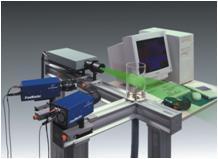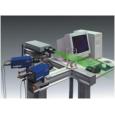方案详情
文
采用LaVision公司的DaVis7.0.11图像数据采集和分析处理软件平台,两台 imager Pro CCD 相机,可编程时间控制单元PTU构成一套2D3C立体粒子成像测速系统,并利用该系统研究了被动流量控制在双瓣尖机械心脏瓣膜泄漏射流中的应用。
方案详情

Bileaflet mechanical heart valves (BMHVs), though a life-saving tool in treating heart valve disease, are often associated with serious complications, including a high risk of hemolysis, platelet activation, and thromboembolism. One likely cause of this hyper-coagulative state is the nonphysiologic levels of stress experienced by the erythrocytes and platelets flowing through the BMHVs. Research has shown that the combination of shear stress magnitude and exposure time found in the highly transient leakage jet emanating from the b-datum gap during valve closure is sufficient to cause hemolysis and platelet activation. Regions of flow stasis in the valve vicinity may also allow activated platelets to aggregate and form thrombus. This thesis addresses the hypothesis that passive flow control may have the potential to reduce flow-induced thrombogenicity by altering the fluid mechanics of bileaflet mechanical heart valves. To test this hypothesis, a steady model of the regurgitant b-datum line jet was developed and studied. This model served as a test bed for various vortex generator array designs. The fluid mechanics of the b-datum line jet model was investigated with flow visualization and particle image velocimetry. In vitro tests with whole human blood were performed with and without the vortex generators in order to determine how the presence of the passive flow control affected the propensity of the blood to form thrombus. An effort was then made to correlate the fluid mechanics of the jet model with the procoagulant potential results from the blood experiments. The effect of the vortex generators on the fluid mechanics of the valve under physiologic pulsatile conditions was also investigated via flow visualization in the Georgia Tech Left Heart Simulator. By studying a steady model of the regurgitant b-datum line jet, it was found, using an in vitro system with whole human blood, that the presence of vortex generators significantly decreased the blood’s propensity for thrombus formation. The potential of applying passive flow control to cardiovascular hardware in order to mitigate the injurious effects of shear-induced platelet activation is thus demonstrated. The investigation into the effect of vortex generators on the fluid mechanics of the b-datum line jet showed that the jet oscillated aperiodically and that the effect of the applied flow control was played out at both the scale of the chamber (large-scale) and on the scale of the vortex generator fins (small-scale). On the large scale, the presence of vortex generators appeared to decrease the magnitude or frequency of jet oscillation, thereby stabilizing the jet. After removing the effect of the large-scale oscillations via phase averaging, the effect of the vortex generators on the small scale was examined. On the small scale, the jet without flow control was found to have higher levels of velocity RMS, particularly on the jet periphery, and higher levels of Reynolds shear stress. It is proposed that the vortex generators effect this change by generating vorticity in the plane of the jet. This vorticity is theorized to stabilize the jet, delaying roll-up of the jet shear layer which occurs via the Kelvin-Helmholtz instability. The method by which the vortex generators acted on the fluid mechanics of the steady jet system to decrease the blood’s procoagulant potential was investigated via flow visualization and DPIV. The results from these studies implicate two possible mechanisms by which the vortex generators may act. First, the peak turbulent shear stresses in the jet were reduced by 10-20% with the application of vortex generators. Even if only a few platelets were activated in each passage through the valve, the cumulative effect of this difference in peak stresses after many passes would be greatly magnified. Thus, this reduction in turbulent shear stresses may be sufficient to explain the change seen in the blood’s procoagulant potential with the application of passive flow control. It is suspected, though, that the second mechanism is dominant. The flow fields revealed that the presence of the vortex generators delayed or prevented the roll-up of the Kelvin-Helmholtz instability in the b-datum jet’s shear layers into discrete vortices. By doing so, it is thought that opportunities for the interaction of activated and unactivated platelets entrained in these vortices were prevented, thereby inhibiting further propagation of the coagulation cascade. Even if the rate at which platelets were activated was similar for cases with and without flow control, it seems that the flow fields experienced by the platelets subsequent to activation can determine the level of procoagulant potential. Under the steady conditions observed in this experiment, the jet influenced by vortex generators was thus shown to induce significantly lower levels of procoagulant potential.
确定
产品配置单
北京欧兰科技发展有限公司为您提供《双瓣尖机械心脏瓣膜中2D3C速度矢量场检测方案(粒子图像测速)》,该方案主要用于内脏器官中2D3C速度矢量场检测,参考标准--,《双瓣尖机械心脏瓣膜中2D3C速度矢量场检测方案(粒子图像测速)》用到的仪器有三维立体PIV、LaVision DaVis 智能成像软件平台
推荐专场
相关方案
更多
该厂商其他方案
更多

















